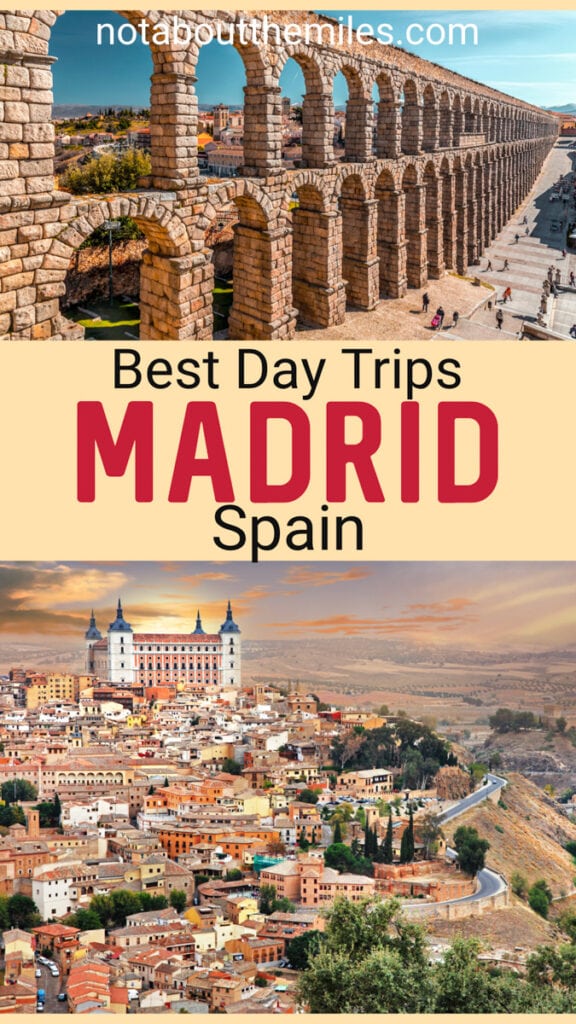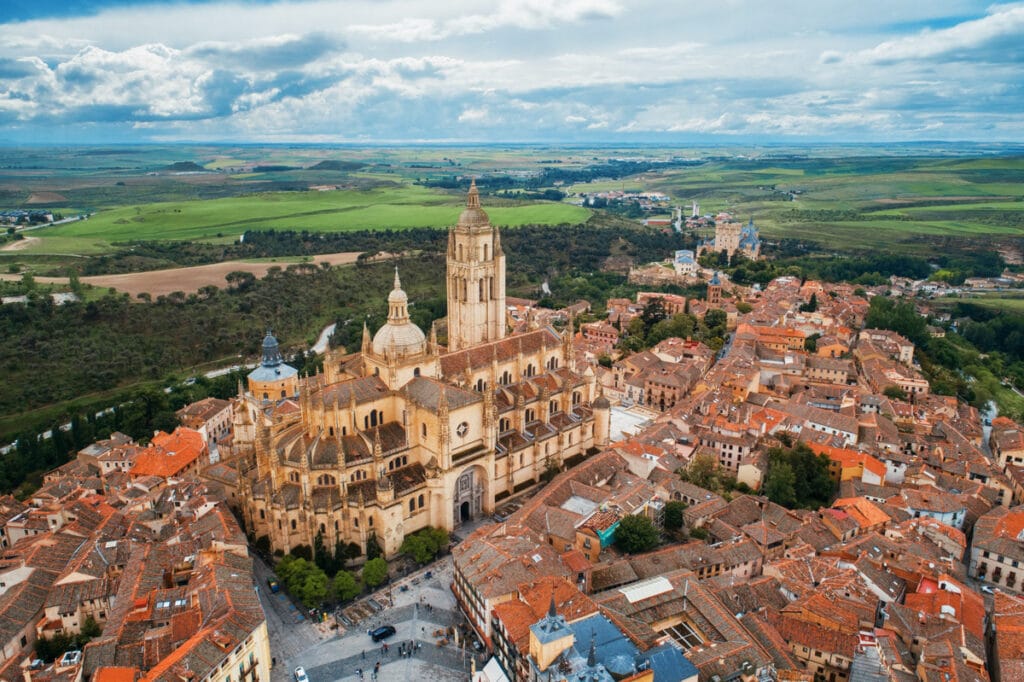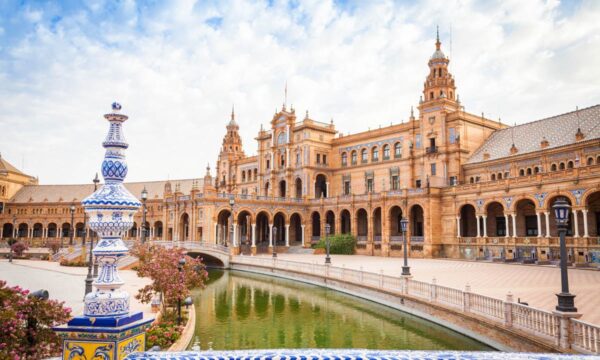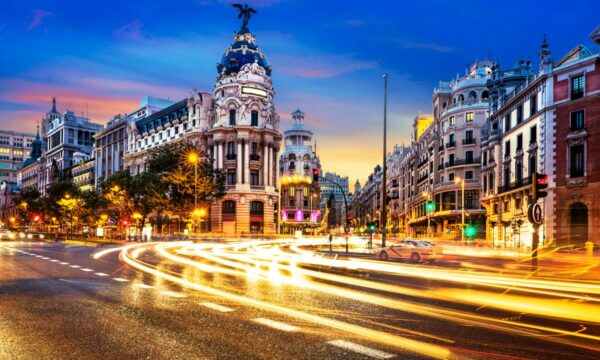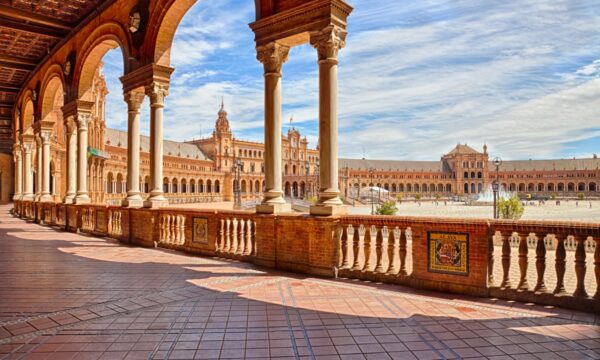Visiting the Spanish capital of Madrid? Be sure to leave room in your Spain itinerary for some of these fabulous day trips from Madrid!
Centrally-located Madrid is not only a great city to visit in its own right, it is also well-connected to other historic cities and towns that you can easily visit for the day.
Connecting with Spain’s colorful past is a breeze on these Madrid day trips.
You’ll find numerous UNESCO World Heritage Sites in our round-up of the best day trips from Madrid. Lovers of art, architecture, and history are spoiled for choice on which Madrid day trips to choose.
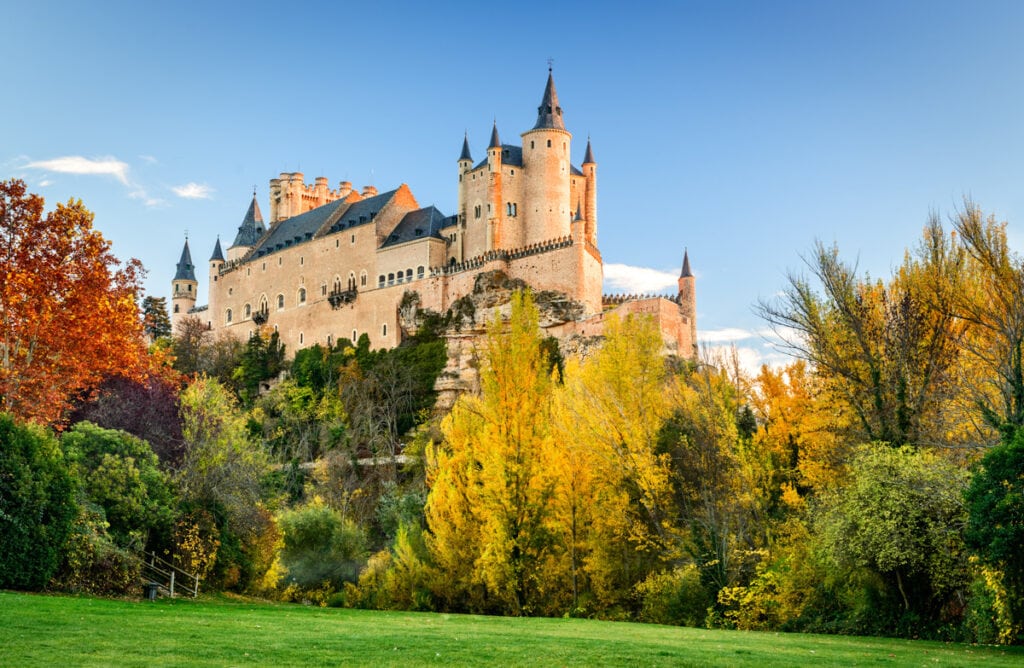
Some links on this page may be affiliate links. If you click an affiliate link and make a purchase, we may receive a small commission, at no extra cost to you. For more details, refer to our disclosure.
From picture-perfect Toledo and historic Segovia to the Andalusian cities of Cordoba and Seville, and the beaches of Alicante and Valencia, you can explore many diverse destinations on day excursions from Madrid.
All of the places we’ve described can be accessed by train. In fact, the high-speed train is the best and sometimes the only realistic means to visit some of these places for the day.
Of course, if you have a car and are on a Spain road trip, you can also drive yourself to these day trip destinations.
Excited? Let’s get started discovering the very best day trips from Madrid!
1. Toledo
Without a doubt, one of the most popular day trips from Madrid is to the ancient Central Spain city of Toledo, just south of Madrid.
Toledo’s historic quarter is a UNESCO World Heritage Site. It’s one of the most beautiful places to visit in Spain, and one of the easiest day trips from Madrid by train.
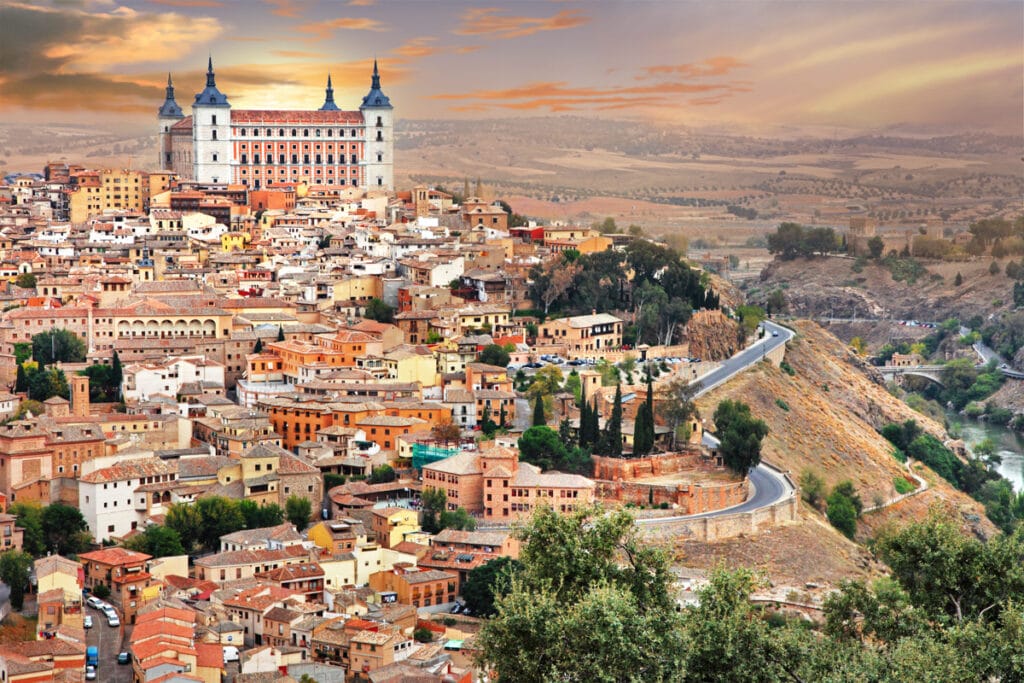
Known as “the City of Three Cultures,” Toledo has cultural influences of Jews, Christians, and Muslims woven into its history and heritage.
One of the must-visit landmarks in Toledo is the magnificent Gothic cathedral. The white limestone structure has a dazzling interior, with lots of gold. It has a single graceful tower.
A stone fortress built at the top of the highest point in Toledo, the city’s Alcazar forms the backdrop for stunning photos of the city. Today the Alcazar houses a military museum.
Wander the picturesque streets of Toledo to savor the ambience. Stroll across the pretty bridges, the Puente de San Martín and the Puente de Alcántara. They make for great photo spots! Linger for a bit at the Plaza de Zocodover, the main square.
The imposing Puerta de Bisagra, the main gate, is definitely worth a stop. It’s the only surviving part of the Moorish walls that once encircled the city.
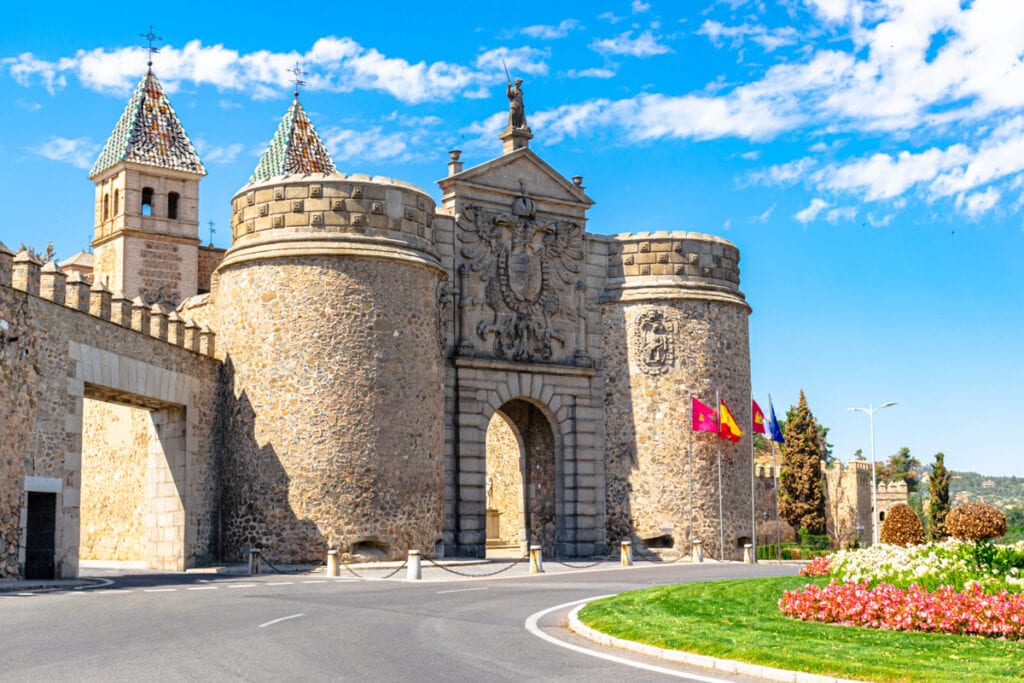
The Monasterio de San Juan de los Reyes was built under Ferdinand and Isabella, the Catholic Monarchs. It’s one of the most spectacular structures in Toledo, with two levels of cloisters and beautiful gardens.
Make sure to save time to snap photos of Toledo from a viewpoint across the river. The view is particularly stunning around sunset. To save time, you can take a taxi or the local bus to the Mirador del Valle.
If you book the Toledo Hop On, Hop Off bus tour, the miradors are stops on the route.
Toledo is a year-round destination, but spring and fall are ideal for lower crowds and pleasant weather.
Semana Santa (Easter week) is celebrated with processions in Toledo, and the procession of Corpus Christi, which occurs on the Sunday of the ninth week after Holy Week, is very famous.
Getting to Toledo from Madrid
The high-speed train from Madrid Atocha to Toledo is the most convenient way to get to Toledo for your day trip: the journey takes just 30 minutes. There are multiple departures each day.
The train station is at the bottom of the hill in Toledo, so you’ll want to take a local bus to the Plaza de Zocodover to begin your sightseeing. You can also opt for a taxi.
You can also travel from Madrid to Toledo (and back) by bus. It’s cheaper than the high-speed train, but takes twice the time (or more) each way.
If you have a car, you can drive from Madrid to Toledo in just under an hour, along the A-42.
A guided tour is a great way to explore historic Toledo: you will learn a lot about its fascinating history as you explore.
This highly-rated full day tour of Toledo includes a stop at a couple of panoramic viewpoints and a guided walking tour of the historic core.
If your time is limited and you want to see two historic cities on your day out, consider this very popular and well-reviewed guided tour that combines Toledo with Segovia. It also has the option to add on Avila!
In Toledo, you’ll have a photo stop, plus a guided walking tour through the historic center.
Book this guided tour of Toledo and Segovia from Madrid now!
Suggested by us
We book our Spain train tickets on Omio. Their website is in English, and booking is easy and hassle-free for most destinations in Europe. They may charge a nominal booking fee. It’s one fee per booking, and well worth the convenience.
Check availability and buy your train or bus tickets on Omio!
2. Segovia
If you love history and fairytale destinations, then you’ll adore Segovia. It’s one of the most popular one day excursions from Madrid.
The hilltop UNESCO Heritage city dates back to Roman times and is home to one of the most impressive feat of engineering, El Aqueducto or the Aqueduct of Segovia.
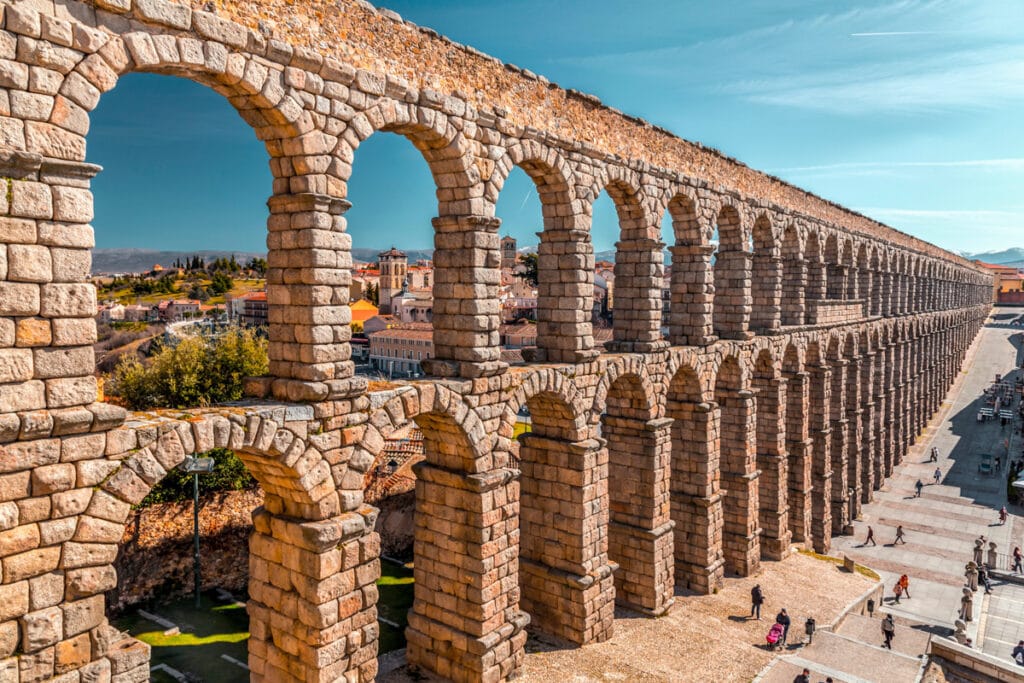
Because of its sheer size and the exceptional way it was built, naturally, several stories have sprung up over the centuries as to how it got there.
One story will tell you about how the god Hercules created the aqueduct, and other stories say it was the devil.
Whichever story you believe, the aqueduct has become the symbol of the city, and you’ll see imagery of it everywhere.
One of the reasons why the aqueduct is so famous is that to this day, it still carries water to the city, just as it did back in Roman times — of course, today there is modern-day plumbing in the city.
Another interesting fact is that gravity that holds the structure together. Carefully cut stones form a multitude of arches that stand to this day.
Although the aqueduct alone is worth the trip to Segovia, there are several other sights certainly worth visiting.
The Alcazar of Segovia is one of them. Perched on a crop of rock, its bluish spires resemble something from a fairytale movie.
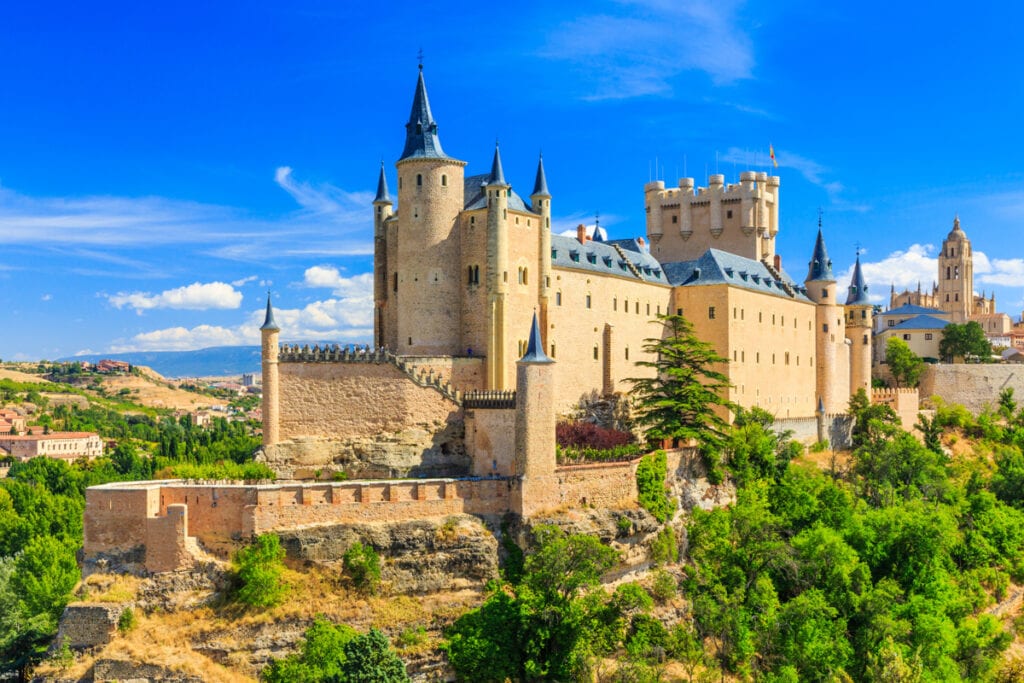
It’s worth going inside to climb the towers that look out over the city from one side, and the rolling countryside on the other.
Twin this with the Gothic cathedral, city walls, and a well-preserved Jewish quarter of maze-like cobbled streets, and you’ll soon see why Segovia is a great day trip from Madrid.
Segovia is popular all year round. In the summer, visits coincide with the European holidays, and in winter the Christmas markets bring in the crowds.
Plan to visit in the shoulder season, and if you want to photograph the aqueduct without anyone in it, then you’ll have to be up at first light.
Getting to Segovia from Madrid
Segovia is well connected to Madrid by road, bus and train. Parking can be an issue, especially at peak times, so the best option is to get the train.
Get the train from the Atocha station in Madrid: the journey takes just over an hour.
Segovia train station is about a 15-minute walk from the historical center.
You can drive to Segovia from Madrid in about an hour.
You’ll also find guided day tours from Madrid to Segovia, sometimes in combination with Avila. This super popular tour (with 1,800 five-star reviews at the time of writing) takes about 9 hours.
The tour includes guided walking tours in both cities, and entry fees.
On this tour, in Segovia you’ll visit the Segovia Aqueduct, plus the Alcazar and the Segovia Cathedral.
Suggested by Becki from Meet Me In Departures
Looking for a car rental for your Spain road trip? We’ve had great experience booking with Discover Cars: they offer deals across several different providers and have a wide selection of cars on offer.
Check availability and book your rental car now!
3. Ávila
Along with Toledo and Segovia, the historic city of Ávila makes up the trio of the most popular day trips from Madrid.
Avila is known for its well-preserved medieval city walls, studded with towers and gates. It’s an incredible sight!
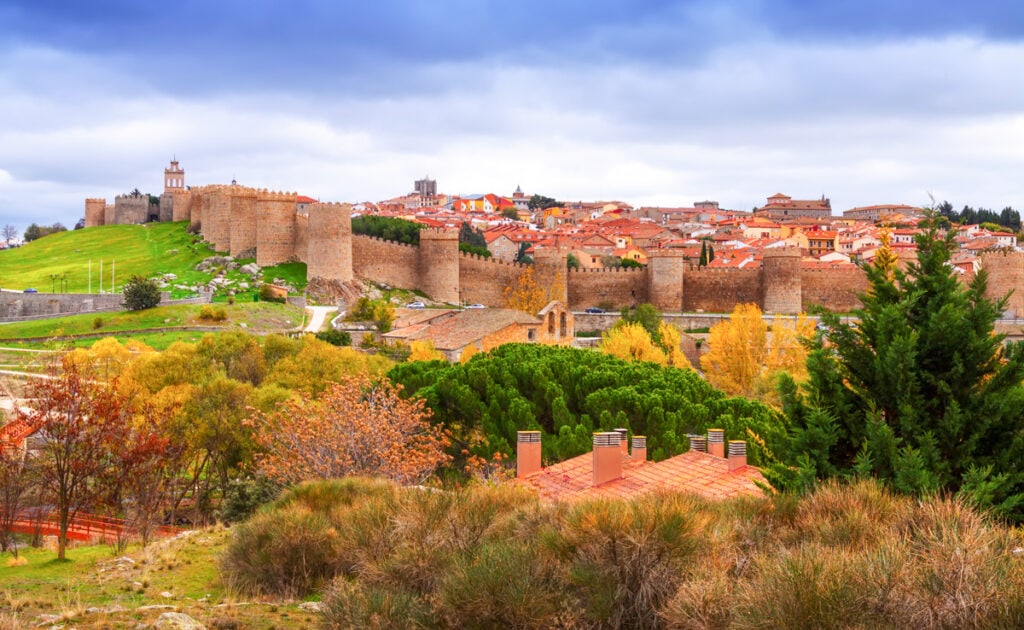
The Old Town of Ávila is a UNESCO World Heritage Site.
Las Murallas de Avila, the city walls, are the top attraction in Avila. You can walk along the walls for views of the city inside and the countryside outside. Enter via the gate by the cathedral.
You can also walk the length of the walls at the bottom, if you do not wish to climb to the top. If you stay late, you can see them illuminated!
The Basilica de San Vicente is a gorgeous Romanesque church that dates back to the 11th century. Over the years, it’s been modified to include other styles such as Gothic and Renaissance. The ornate interior is a must-visit!
The Avila Cathedral is the other major church to visit. It’s a huge stone and brick Gothic structure, and the apse is actually one of the turrets of the city walls!
Avila is the birthplace of Saint Teresa, and you will find many churches and monasteries related to the saint in Avila, including the Convento de Santa Teresa. The church has a Baroque facade and a lovely interior. The plaza is picturesque as well.
Round out your exploration of religious sites with the Museo del Convento de la Encarnacion, where you can get a sense for how Saint Teresa lived. The museum includes her monastic cell and many of her written works.
Wander the streets of Avila and linger for a bit in the Plaza Mayor. For lunch, try chuleton de Avila, a gigantic barbecued cut of veal served on a wooden slab with potatoes and other vegetables. It definitely serves more than one! Also sample yemas, the local dessert!
You can visit Avila year-round, but spring and fall are ideal times to visit, with lower crowds and great weather. Winters are cold, with rain and snow, so bundle up if you decide to visit in the winter!
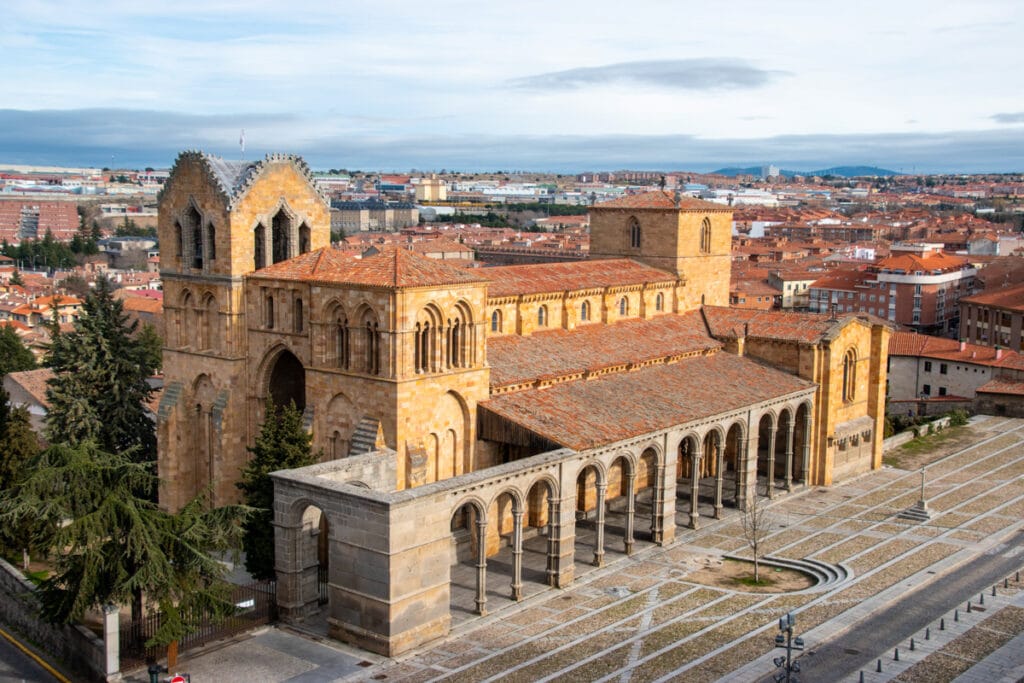
Getting to Avila from Madrid
Avila is connected to Madrid by both train and bus.
The train journey takes about one hour and 30 minutes each way. There are many departures each day.
It’s about a 15-minute walk from the train station in Avila to the historic center.
The fastest buses take about one hour and 20 minutes, and tickets are cheaper than the train, but there are fewer departures, so check the schedule for the day of your trip to choose between the train and the bus.
If you have a car, you can drive to Avila from Madrid in about one hour and 30 minutes.
Avila, in conjunction with Segovia, is the most popular guided day tour from Madrid. This highly-rated tour takes about 9 hours and includes coach transfers, guided walks in both cities, and entry fees.
This other popular guided tour option includes Segovia, Toledo, and Avila for an efficient tour of medieval Spain from Madrid! The well-reviewed full-day tour makes for a long day: 11 to 13 hours, and includes walking tours in each city.
Suggested by us
4. Salamanca
Salamanca is one of the best day trips from Madrid if you love an academic atmosphere, cultural emersion, and plateresque architecture.
It only takes one hour and 40 minutes on a high-speed train to enjoy the place locals lovingly call the Golden City.
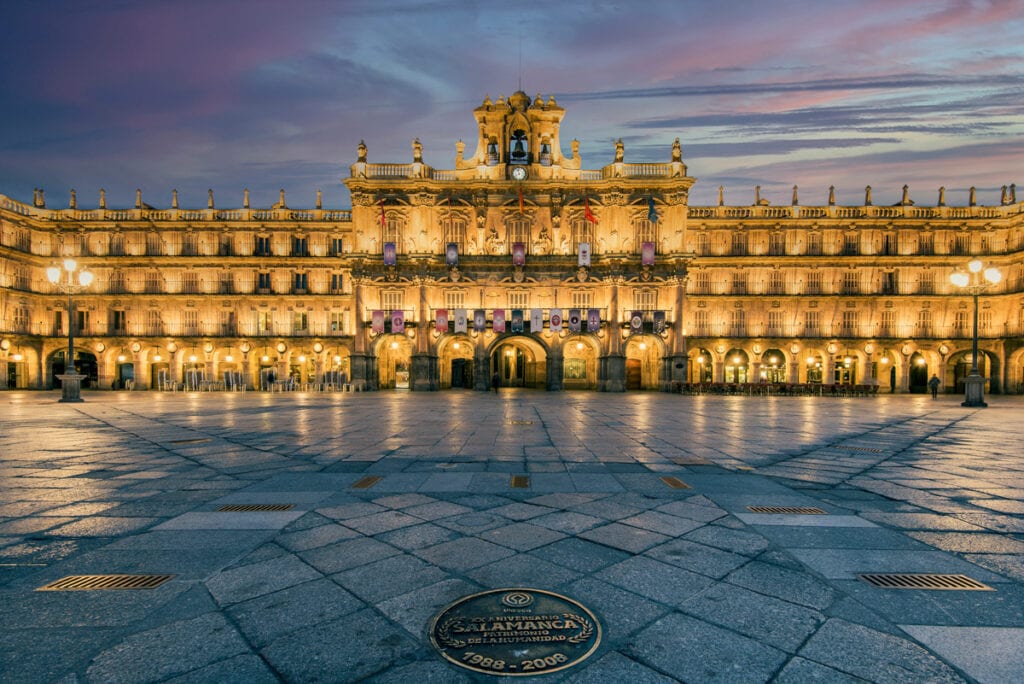
Upon your arrival, make a beeline for the University of Salamanca. It’s one of the oldest universities in the world still in operation, and for a small fee, you can enter the main university grounds to see where its 25,000+ students learn.
Then head to Plaza Mayor. It’s a great place to grab an ice cream by day and watch cultural performances by night.
The plaza isn’t a perfect square, so try to guess which of its four arched walls is the longest!
The nearby Salamanca Cathedral is also a must-see. You’ll get a two-for-one deal with your entrance ticket, for the Salamanca Cathedral has an old and new cathedral side. Art lovers will delight in its paintings.
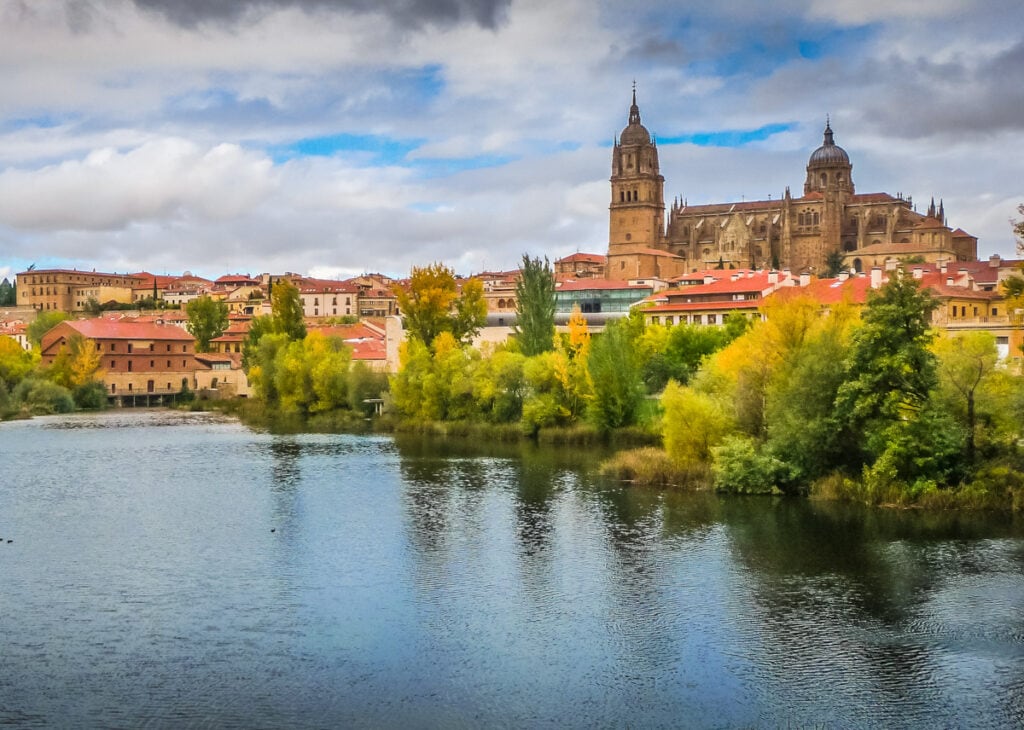
Don’t leave Salamanca without admiring the House of Shells. The plateresque-style library has dozens of ornamental scallop shells on its outer walls.
It’s a great free place to see in Salamanca, and its perimeter is accessible for people with limited mobility.
The best time of year to visit Salamanca is from June to October, as the weather is warm and rain is rare.
September brings the opportunity to experience the Salamanca Fair, a more-than-one-week festival with parades, cultural performances, and concerts.
Getting to Salamanca from Madrid
Taking the direct high-speed train from the Chamartín train station in Madrid is the best way to arrive in Salamanca.
The journey takes one hour and 36 minutes. It’s about a 25-minute walk from the Salamanca train station to the University.
If you have a car, you can drive from Madrid to Salamanca in about 2 hours and 15 minutes via the A-50.
You can travel by public bus as well, although the journey takes much longer and will eat into your precious sightseeing time.
Like the structure of a guided tour? This well-reviewed tour combines Salamanca with Avila for a full-day trip from Madrid (about 11 hours).
The tour price includes entrance to Salamanca’s cathedral.
Book this guided tour of Salamanca (and Avila) from Madrid now!
Suggested by Laura from A Piece of Travel
5. Alcala de Henares
While first-time visitors to the Spanish capital might overlook Alcalá de Henares, it’s one of the easiest and best places to visit outside Madrid.
Being the birthplace of Miguel de Cervantes, the author of Don Quixote (considered the first ever modern novel), the home of one the world’s oldest universities, and a place of great Roman, medieval, and Jewish history, this city is definitely worth visiting.
One of the best things to do in Alcala de Henares is to explore its historic center, a UNESCO World Heritage Site.
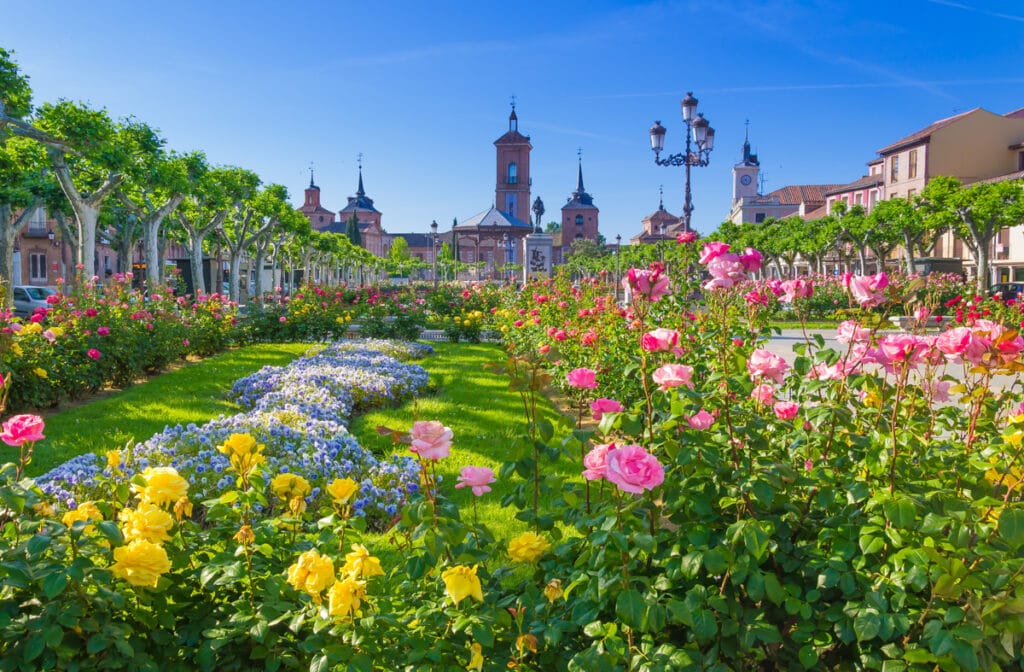
Be sure to marvel at the picture-perfect Cervantes Square, visit the Cervantes Birthplace Museum (where the novelist was born and raised), and walk along the beautiful Calle Mayor, which was an important commercial hub and a part of the Jewish quarter.
Near the historic center, you can also see some of the remains of the medieval wall that once surrounded the city.
The wall defended the Archbishop’s Palace, a significant monument that served as the residence of archbishops and monarchs and witnessed events such as the birth of Catherine of Aragon.
Next, visit the Laredo Palace, a Neo-Mudéjar architectural gem that functions as a museum dedicated to Cardinal Cisneros, the Franciscan cardinal that founded Alcala de Henares’ university in 1500.
Last but not least, to follow the city’s Roman history, head to the archeological sites of the Roman City of Complutum and the House of Hippolytus.
Alcala de Henares is a year-round destination, though a very special event takes place in October around Cervantes’ baptism date, called Semana Cervantina (Cervantes Week).
Dedicated to the iconic author, the festival includes all kinds of Golden-Age-themed events, like theatre performances, workshops, and even Don-Quixote-inspired feasts.
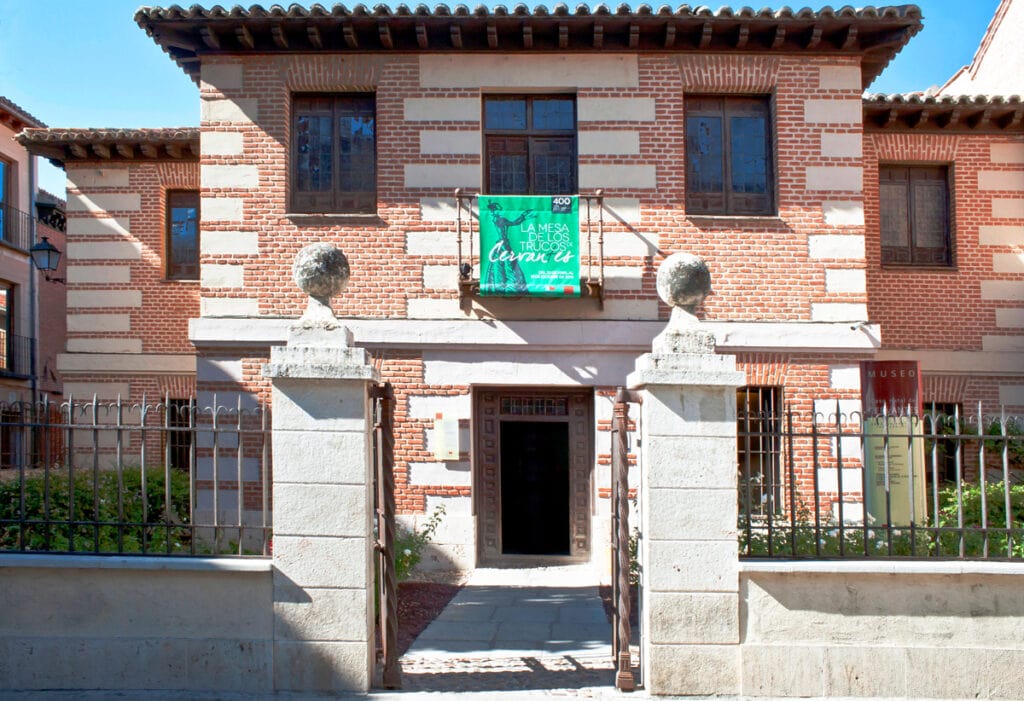
Getting to Alcala de Henares from Madrid
Using Madrid’s suburban train (Cercanias), it’s extremely easy to get to Alcala de Henares in less than 45 minutes, with lines C2 and C7 both leaving the Atocha train station frequently.
It’s about a 12-15 minute walk from the train station in Alcala de Henares to the historic center.
If you have a car, you can drive from Madrid to Alcala de Henares in about 35 minutes.
You can also visit on a guided tour: this well-reviewed tour takes about 5 hours and includes several Cervantes-related sights, including the house where he was born.
A guided walking tour of the historic center and entry fees to monuments are included in the tour price.
Suggested by Or from My Path in the World
6. El Escorial
San Lorenzo de el Escorial, also known as the Royal Seat of San Lorenzo of El Escorial, is a giant palace owned by the Spanish royal family.
It has had many different uses over the years, including operating as a school, monastery and even a hospital.
Built in the 16th century during the reign of King Phillip II, El Monasterio del Escorial is the largest Renaissance building on the planet and a UNESCO World Heritage Site.
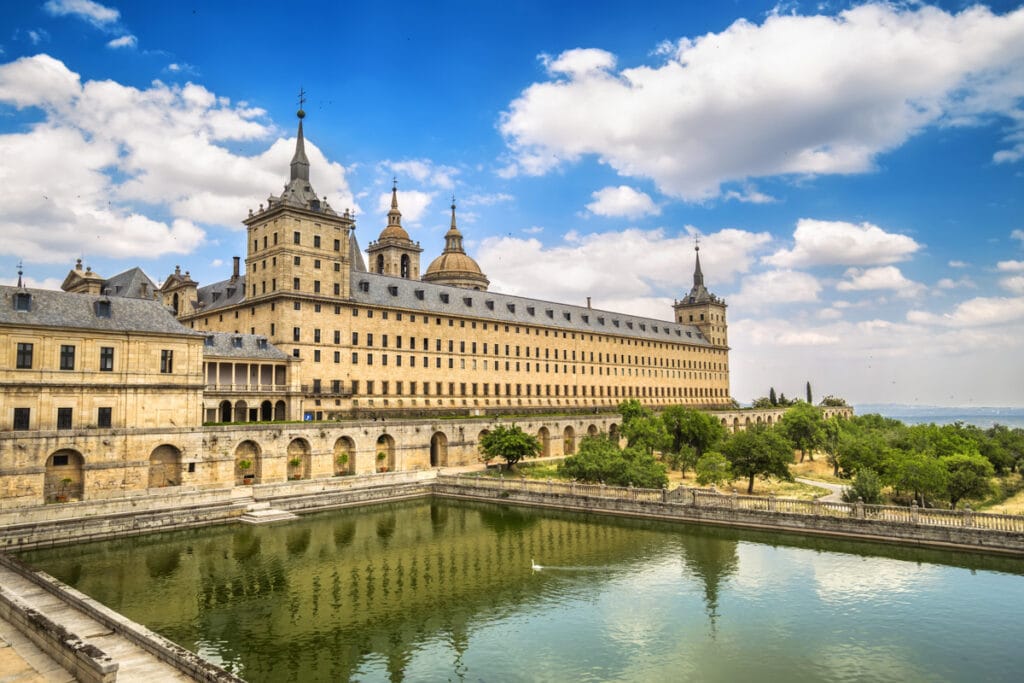
It’s the final resting place for many Spanish royals and the crypts can be visited by tourists.
El Escorial is one of the best day trips from Madrid to put on your itinerary if you enjoy history, architecture, art, and gardens.
You’ll get to walk the ancient halls, which date back to the 16th century, and admire the incredible art and historic artifacts.
Keep in mind that there is no photography allowed in most parts of the palace to protect the delicate artwork and murals.
After exploring the palace, wander the adjacent gardens as well. The gardens are carefully manicured and provide beautiful views over the surrounding hills and of course El Escorial itself.
The gardens are free to visit and a great spot for a picnic after an exciting day of exploring.
El Escorial is one of Spain’s most famous landmarks and a major tourist attraction so make sure to arrive early in the morning and avoid weekends, especially during the warmer months.
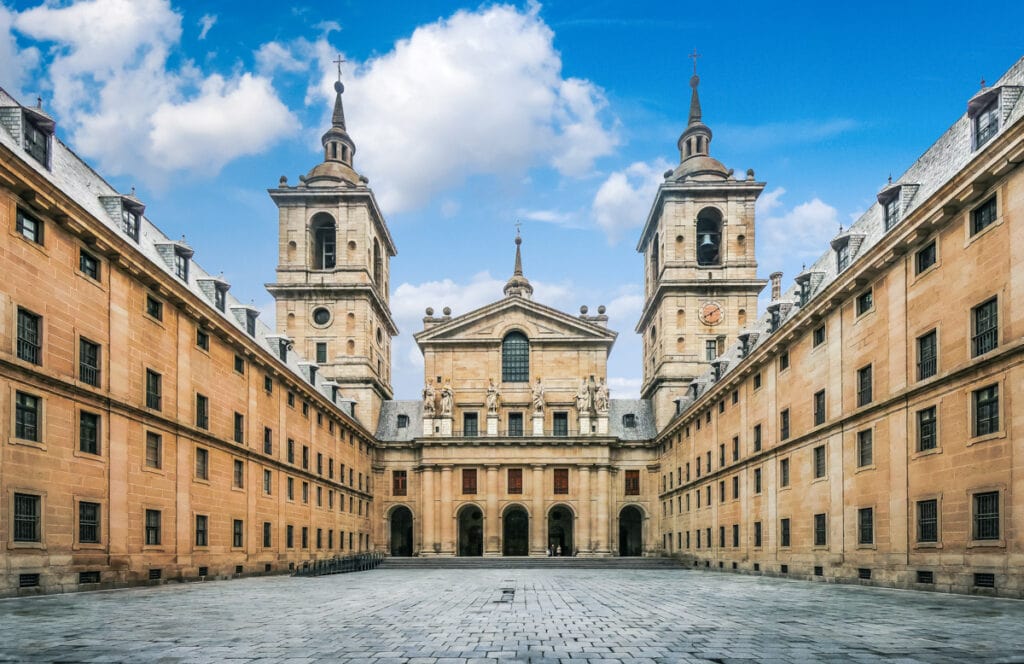
The best time to visit El Escorial is in spring or early fall, when the gardens are still green and there is a good chance of sunny weather.
Summer is often extremely hot in this area and there is no air conditioning in most areas so avoid this time of year if possible.
General adult entrance tickets cost 12€ per person at the time of writing.
Getting to El Escorial from Madrid
El Escorial is located about one hour from Madrid and can easily be reached either by bus, train, or car.
You can take a commuter train from various Madrid stations to El Escorial, and the ride takes about 40 minutes to one hour. It’s about a 10-minute walk from the station to El Escorial.
You can also take the public bus from Madrid to El Escorial, with the ride taking about 45 minutes to one hour. It’s a very short walk from the bus stop to the monastery.
Want to visit on a guided tour? This highly-rated 5-hour tour takes you to the monastery and back in an air-conditioned luxury bus.
You will also visit the Valley of the Fallen Monument and the Catholic Basilica.
Learn about the sites as you explore with a knowledgable guide.
Entrance fees are included in the tour price.
Suggested by Victoria from Guide Your Travel
7. Cuenca
Known for its “hanging houses,” Cuenca makes for a fascinating day trip from Madrid. With its precipitous location along a gorge, Cuenca is well-deserving of its nickname, “Eagle’s Nest.”
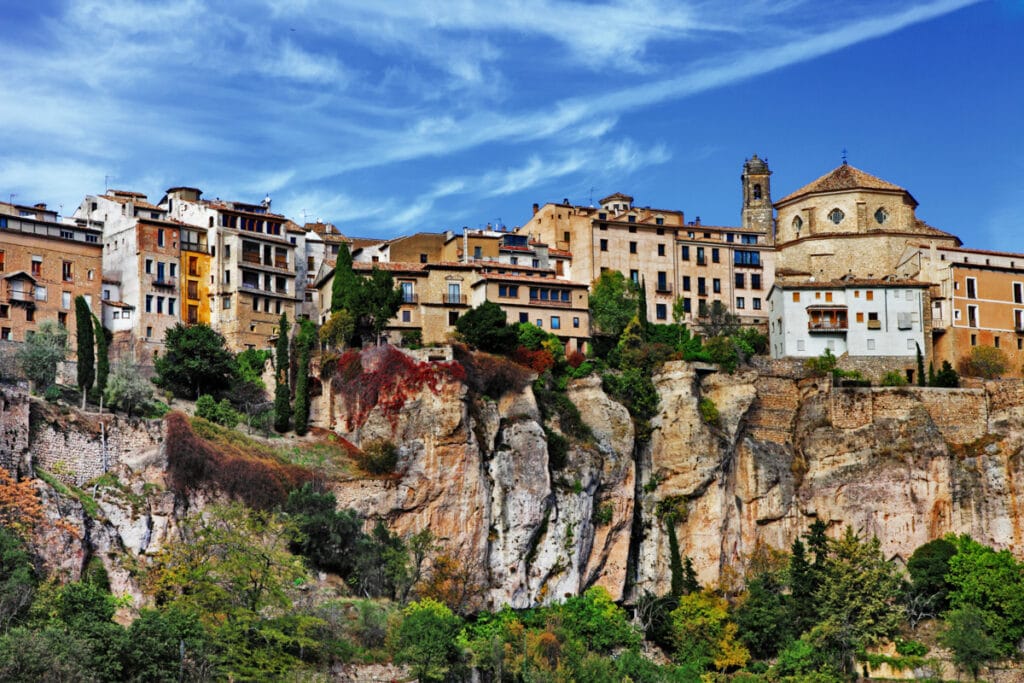
The Moors established the town in the 8th century, building a walled fortress, the ruins of which can still be seen.
Cuenca, like many of the other day trip destinations from Madrid we’ve described, is a UNESCO World Heritage Site, and one of the must-see towns near Madrid..
You can explore Cuenca on foot, or take the little tourist train.
Walk the Puente de San Pablo, the early 20th century bridge that leads into the old town. This bridge replaces one that was built in the 16th century. The bridge connects the hanging houses with the Convent of San Pablo (now a Parador hotel) and offers great views of both sides.
The Casa Colgadas, or the Hanging Houses, are the most famous attraction in Cuenca. Perched at the very edge of steep cliffs, these houses are a must-see! They overlook the Huécar River.
Stroll the Plaza Mayor, where you will find the magnificent Gothic Cuenca Cathedral. Inside, the light (from modern stained glass windows) is gorgeous, and you can admire the religious art and the ribbed vaulted ceiling. The sunken chapel is also beautiful.
Wander the streets of the old town (Alfonso VIII Street is beautiful!), explore the underground tunnels, admire the Mangana Tower, and tour the remnants of the old castle: it offers fabulous views.
If you’ve arrived by car, you will also want to drive to La Ciudad Encantada, a natural area in the town of Valdecabras, in the middle of the Serranía de Cuenca. Here you will find gorgeous rock formations to admire, many of them named.
You can visit Cuenca any time of the year, although spring and fall offer the best weather. Bring warm clothing if you are planning a winter trip.

Getting to Cuenca from Madrid
The high-speed train that runs between Madrid and Valencia stops at Cuenca, and is perfect if you want to visit Cuenca from Madrid for the day.
The journey from Atocha station takes just under an hour each way, and there are several departures in both directions each day.
The AVE trains stop at the Fernando Zobel train station in Cuenca, which is a few kilometers outside the town. You can take a bus to the bottom of the hill and another up to Plaza Mayor (about 30 minutes or so), or just take a taxi from the AVE station to the old town.
If you have a car, you can drive from Madrid to Cuenca in about one hour and 45 minutes.
Prefer a guided tour? This highly-rated tour of Cuenca and the Enchanted City takes about 11 hours. The tour price includes admission to the Enchanted City, where you can snap photos at the Devil’s Window.
Book this guided tour of Cuenca and the Enchanted City from Madrid now!
8. Wineries Day Trip from Madrid
If you enjoy wine, consider an all-day wine-tasting tour from Madrid!
Vinos de Madrid is a well-known wine producing area south of Madrid. Grapevines were likely first planted here by the Romans!

Wine production has been documented here since several centuries ago, but the region acquired DOP (Protected Destination of Origin) status in 1990.
There are several varieties of both red and white grapes authorized here, although the recommended white is Albillo Real Malvar and the recommended reds are Garnacha Tinta and Tinto Fino or Tempranillo.
On this highly-rated and popular guided tour, you will visit three wineries, and taste more than ten wines from the Madrid DO.
Learn about the wine-making processes in the bodegas, admire the beautiful vineyards, and relax in the peace of the countryside.
The small group tour maxes out at 19 participants.
9. Cordoba
One of the easiest Madrid day trips by train is to Cordoba.
Cordoba’s magnificent Mezquita is a powerful draw on its own, but the Andalusian city also has a historic Jewish quarter, an alcazar with gorgeous gardens, and pretty patios that offer pops of color in season.
The Mezquita and the historic quarter are UNESCO World Heritage Sites, as is the Festival of Patios, which occurs each year in May.
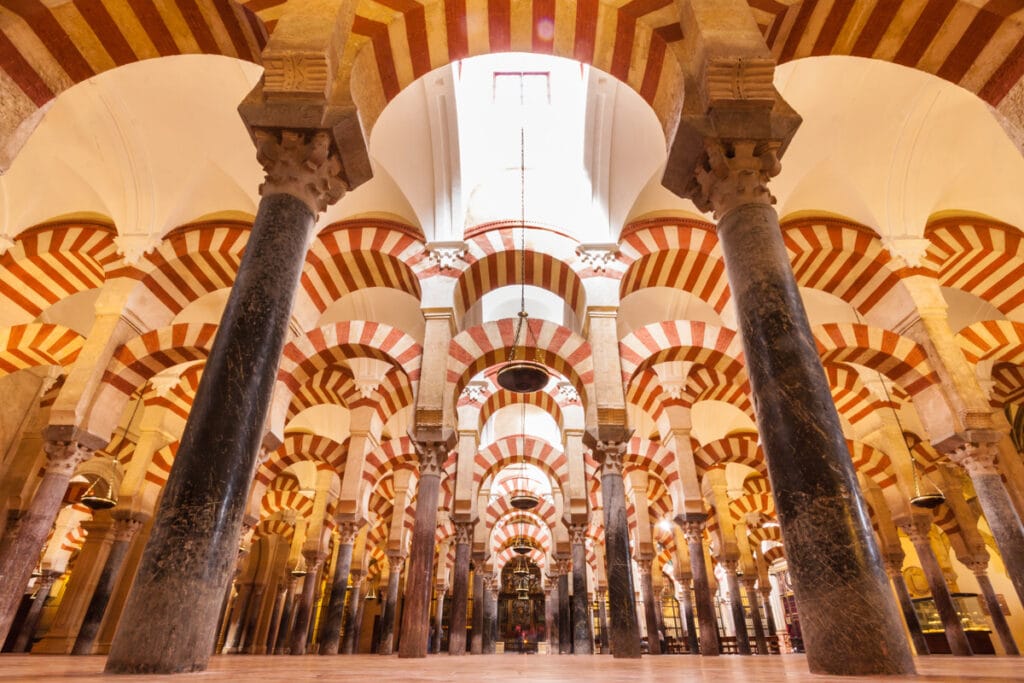
Cordoba is one of the easiest and best day trips from Madrid you can do.
Start by touring the Mezquita, Cordoba’s mosque-cathedral. Visiting the Mezquita is one of the top things to do in Cordoba.
The prayer hall features hundreds of striking red-and-white striped arches, and an ornate mihrab (prayer niche).
The Renaissance Cathedral is built right into the center of the mosque, and features a decorated dome and an ornate altar. Outside, you can linger a while in the Courtyard of the Oranges, and climb to the top of the bell tower for panoramic views.
While Cordoba’s Alcazar is more a fortress than a rich palace today, the views from its ramparts are stunning. Also allow time to stroll the beautiful formal gardens with its many water features, manicured topiary, and boxed flower beds.
Wander the Jewish Quarter, with its maze of narrow cobblestone alleys. Here you will find the medieval Jewish Synagogue, and the statue of the philosopher Maimonides. As you walk, keep an eye out for the city’s colorful patios.
Walk the Roman Bridge across the Guadalquivir River. It featured in Game of Thrones! On the other side, you can climb to the top of the Calahorra Tower for views.
Sample tapas at one of the many tapas bars in the old town: many of them feature terraces with views. Try fried eggplant sticks drizzled with honey, jamon iberico, or salmorejo, a local soup.
Cordoba gets brutally hot in the summer, so plan to visit in the cooler months of the year. Spring is a particularly fine time to visit, with the scent of orange blossoms everywhere, and patios in full bloom.
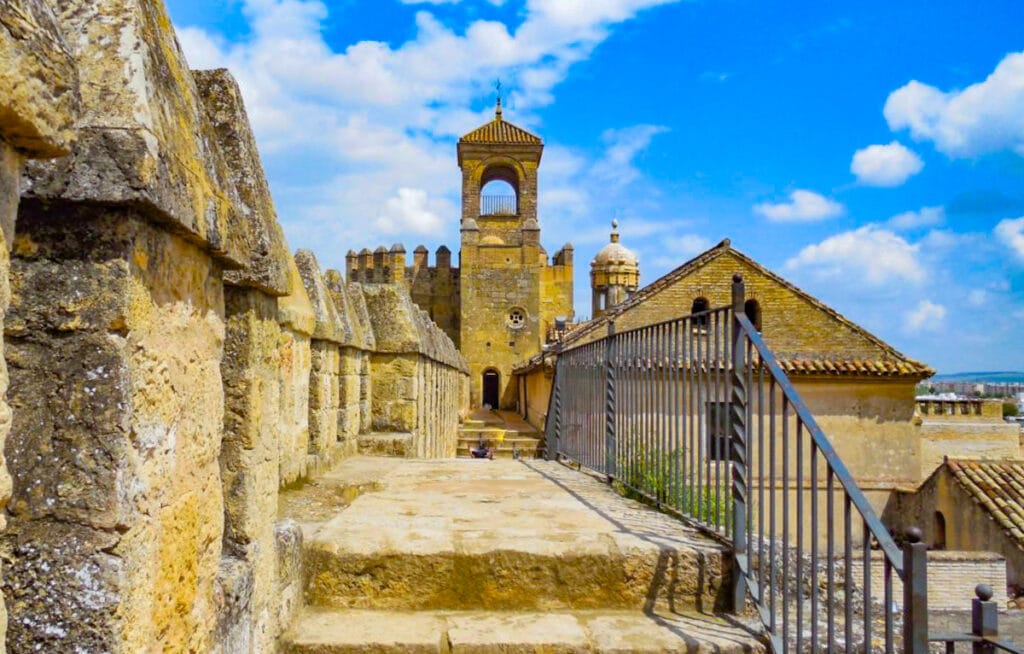
Getting to Cordoba from Madrid
Take the high-speed train from Madrid to Cordoba; it’s the only feasible way to visit for the day.
The journey takes a little under two hours each way, and there are multiple departures each day. From the train station in Cordoba, it’s about a 20-minute walk to the Mezquita.
Suggested by us
10. Aranjuez
Located on the Tagus River south of Madrid, Aranjuez is most well known for the Royal Palace, where the Spanish royals have typically spent the spring season.
Aranjuez, a UNESCO World Heritage Site, is a must-do day trip from Madrid if you love architecture, history, and gardens.
The Royal Palace of Aranjuez was initially built in the 16th century. In the 17th century, fire ravaged a substantial portion of the structure, and it was rebuilt. Its interior decor features Rococo, Moorish, and Chinese influences.
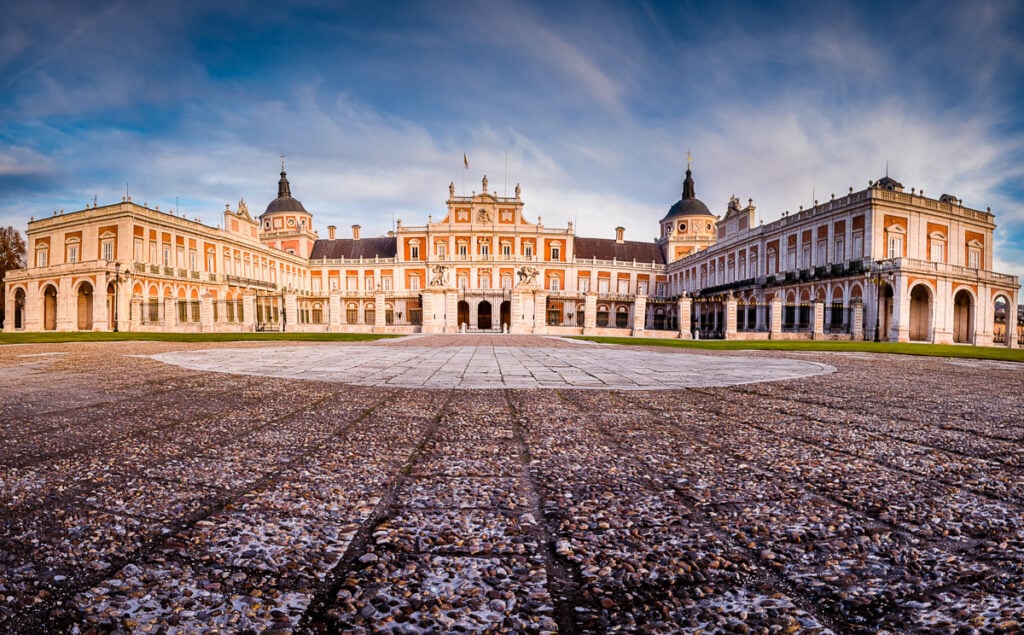
The gardens of the palace are nothing short of stunning, with as much attention and care lavished upon them as on the palace itself. Modeled after Versailles, the gardens feature fountains, statuary, woodlands, and walkways.
Wander the Old Quarter of Aranjuez, deemed a fine example of Baroque town planning, with beautiful buildings and squares. Browse the little shops and admire the architecture and courtyards.
Some of the notable landmarks in town include the Real Iglesia de San Antonio, the erstwhile Hospital de San Carlos, and the Medinaceli Palace. Stop by the Mercado de Abastos for some fresh strawberries on which to snack!
The bullring here is the first built in Spain. Take a tour of the historic site and browse the small museum.
If you are tired of walking, take the Chiquitrén, a tourist train, for a tour of the large and impressive Jardín del Príncipe. Admire the many fountains in the park, the Chinescos pond, and the many mature trees and beautiful plantings. Look for peacocks!
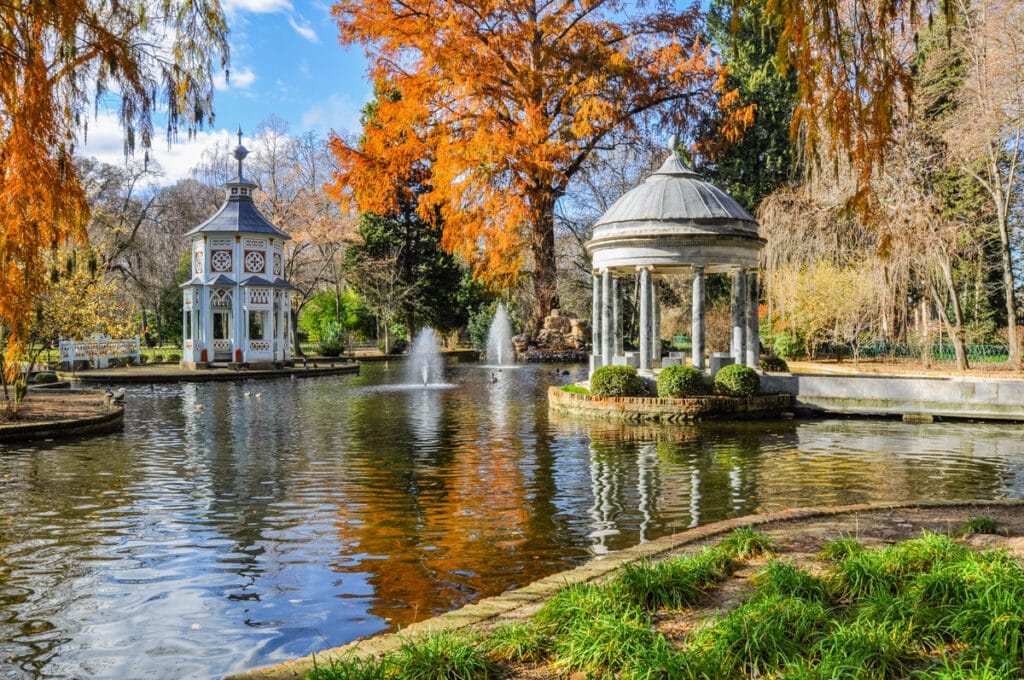
The Royal Barge collection is a must-see in the park, as well as the Real Casa del Labrador, at the end of a walkway lined with magnolias. The interior of the house is arguably one of the most ornate you’ll see anywhere.
You can visit Aranjuez any time of the year, although the gardens will likely be at their best from late spring until fall. The Aranjuez Music Festival is held in late spring each year.
Getting to Aranjuez from Madrid
The train is a convenient way to get from Madrid to Aranjuez and back. Take the C3 line from Chamartin or Atocha in Madrid.
The journey takes about 45 minutes (or a little less) each way, and there are numerous departures. In Aranjuez, it’s a 10-minute walk from the train station to the Royal Palace.
Check out the Strawberry Train, a special period train that runs between Madrid and Aranjuez on many weekends between April and October. En route, you get to sample the famous strawberries!
You can also take the bus from the Estación Sur de Autobuses de Madrid. The journey time is about 50 minutes each way.
If you have a car, you can drive from Madrid to Aranjuez in about 45 minutes.
11. Seville
The capital of Andalusia, Seville will captivate you with its lively ambience. The city is flamboyant Southern Spain at its best. While you need 3 days in Seville to really do it justice, you can still see and do a lot in one day in Seville.
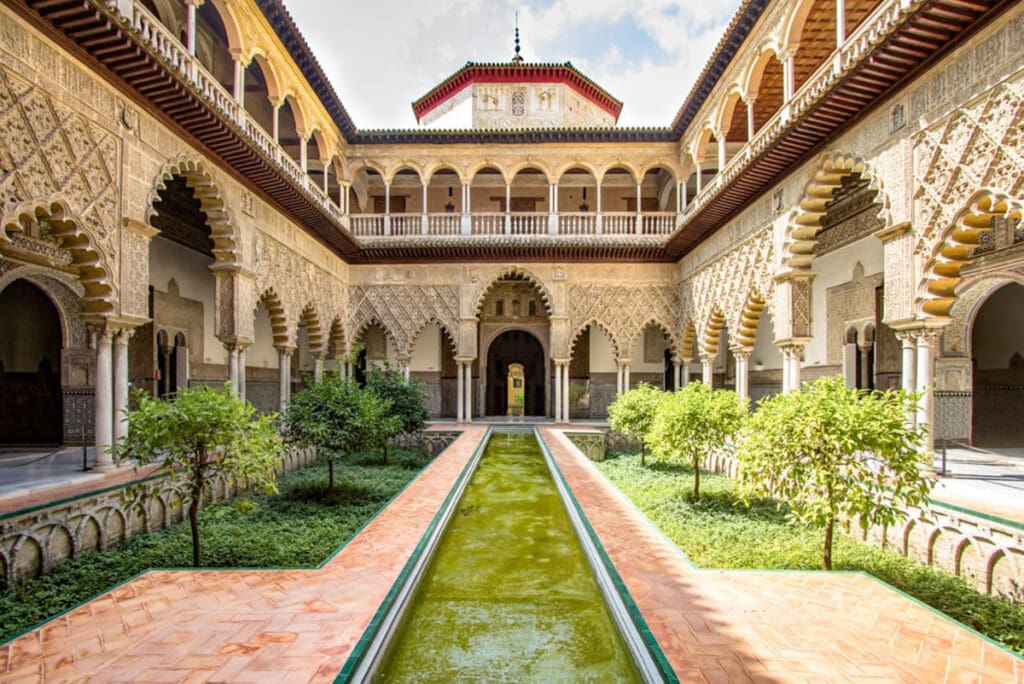
When visiting on a day trip from Madrid, leave early to maximize your sightseeing time in Seville.
One of the top things to do in Seville is strolling the impressive Plaza de Espana. It’s open 24/7, so start your day trip here if you arrive really early in the morning. The tiled displays representing the provinces of Spain are stunning.
Stroll the Maria Luisa Park to the Tower of Gold on the Guadalquivir River before making your way to the Barrio Santa Cruz, the old Jewish Quarter.
The Royal Alcazar of Seville is one of the best examples of Mudejar architecture you can see anywhere. Exploring the Alcazar of Seville is one of the top things to do in Andalusia.
Admire the lace-like arches in the Courtyard of the Maidens, gawk at the ceiling in the Hall of the Ambassadors, see the baths, and stroll the beautiful gardens.
The Seville Cathedral is one of the largest Gothic churches in the world. Inside, the carved scenes from the life of Christ in the Capilla Mayor are covered in dazzling gold. Also view the tomb of explorer Christopher Columbus.
If you enjoy art and architecture, there are several secondary palaces you can tour in Seville, other than the Alcazar. Seville also has a number of museums: the museum of fine arts and the archaeological museum are both worth visiting.
Wander the alleys of Barrio Santa Cruz, and take in the views from the top of Las Setas, the wooden mushrooms that are a somewhat incongruous sight in the historic quarter.
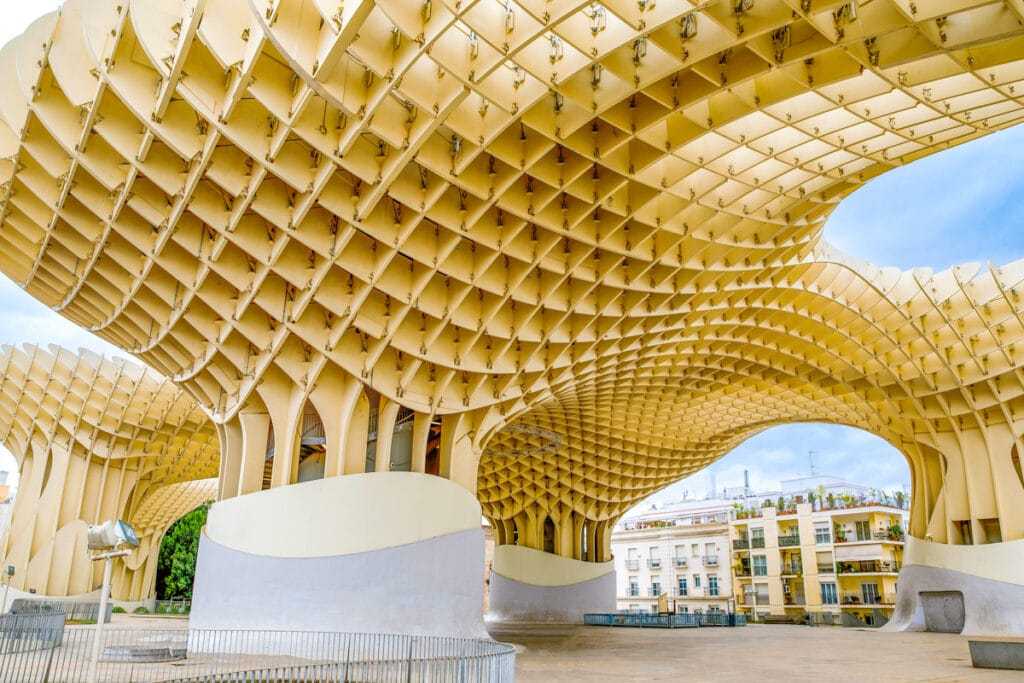
Seville is an excellent place to sample tapas and take in a flamenco performance, before you head back to Madrid.
Seville’s summers are hot, so plan on visiting in spring, fall, or winter. Winter in Seville is an enjoyable time, with Christmas celebrations and mild weather.
Getting to Seville from Madrid
The high-speed train is the best way, and indeed the only feasible way, of doing a day trip from Madrid to Seville. The journey takes about 2.5 hours each way, so you’ll have to leave early to max out your time in Seville.
There are multiple departures in both directions everyday.
From the train station in Seville, take the local bus, or a taxi, into the historic center.
12. Chinchon: an offbeat day trip from Madrid!
Located southeast of Madrid, Chinchon is known for its hilltop houses and pretty surroundings of vineyards and olive groves. It makes for a relaxing day trip from the capital.
Chinchon’s main square, the Plaza Mayor, is its top attraction. It features 234 striking green wood balconies, and picturesque arcades. You’ll want to snap lots of photos of the tiered balconies!
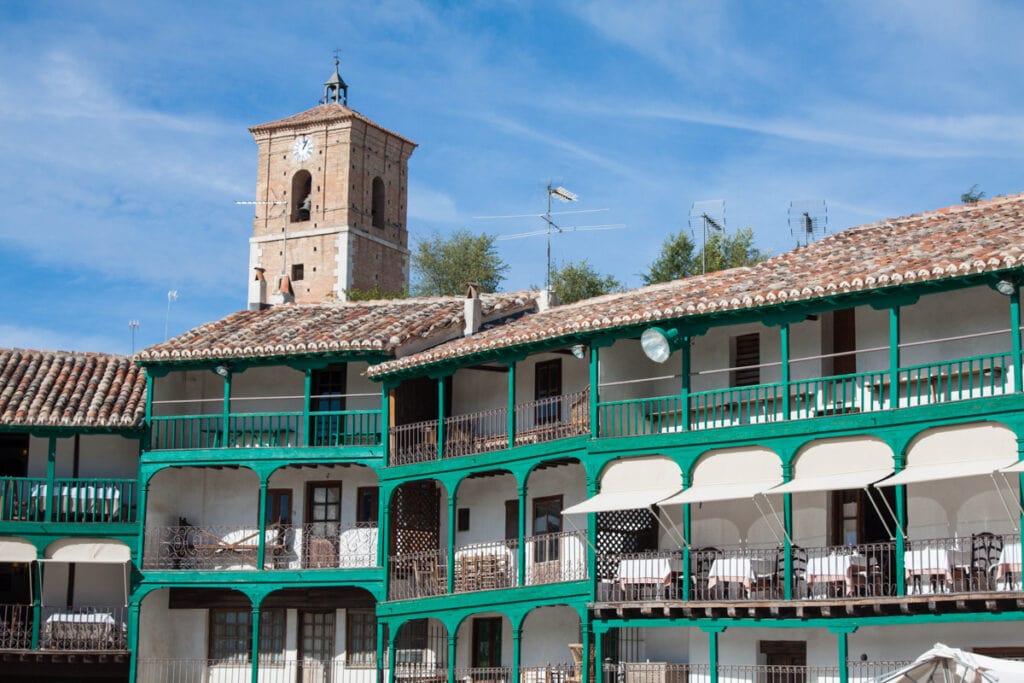
But Chinchon’s main square also functions as the beating heart of the town, serving as the venue for significant events throughout its history. From royal announcements to cattle fairs, the square has seen it all.
The square is lined with restaurants and bars. Pick one for lunch! Meat-centric dishes star here, with kid, suckling pig, or lamb served roasted in a wood-fired oven. Bring cash, many of the restaurants do not accept cards!
Be sure to step into a pasteleria (you’ll find several tucked into the arcades of the square) to sample the many pastries, some in strange shapes.
Only the Clock Tower, the Torre del Reloj, survives from the old church, Nuestra Señora de Gracia. From the viewpoint next to the tower, you get a great view of the town and the ruins of the castle.
The current church, Nuestra Señora de la Asunción, was completed in the 19th century and is a blend of many architectural styles, including Gothic, Renaissance and Baroque.
Inside, do not miss Goya’s magnificent work, La Asunción de la Virgen.
You can also see the ruins of the 15th century Castillo de los Condes, burned by Napoleon’s forces in 1808. The castle offers fabulous views of the valley and the village, and you can see Madrid in the distance on a clear day.
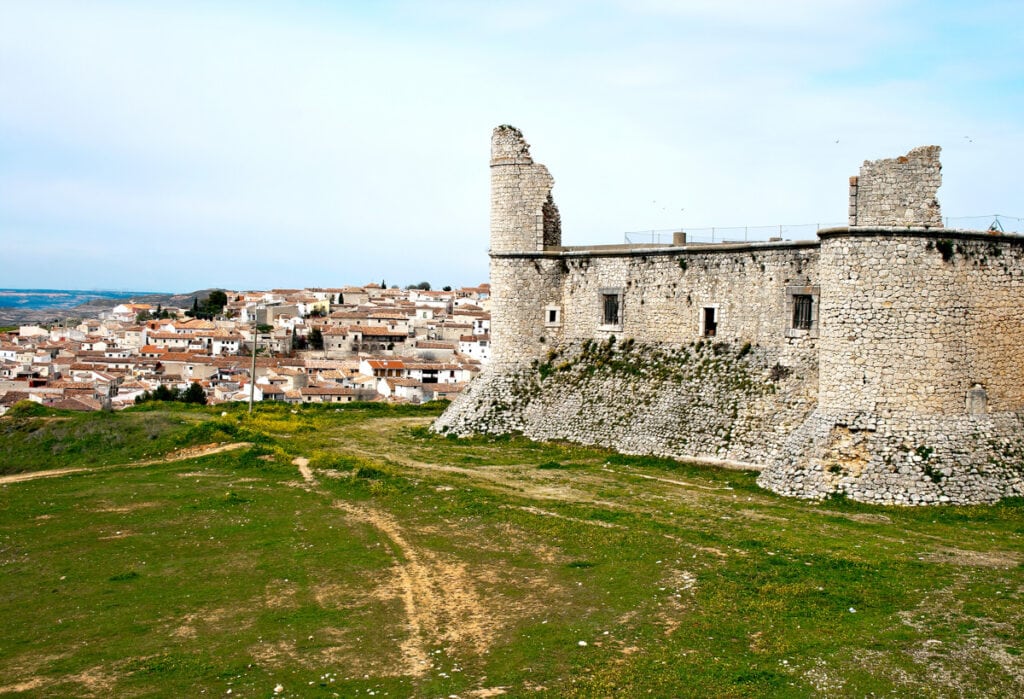
Getting to Chinchon from Madrid
The public bus is an easy way to travel to Chinchon if you do not have a car. Take line 337 from Conde de Casal in Madrid.
There are numerous departures everyday, and the journey time is about one hour (or a little less) each way.
If you have a car, you can drive from Madrid to Chinchon in about 45 minutes.
13. Malaga
Another Andalusian city within day-trip distance of Madrid is the coastal city of Malaga. With beaches, museums, historic landmarks, and an on-point dining scene, Malaga is well worth visiting!
Start your exploration of Malaga by visiting the Alcazaba, the Moorish fortress built on a hill. Enjoy panoramic views over the city and the water. At the foot of the Alcazaba, you’ll find the remains of a Roman theater.
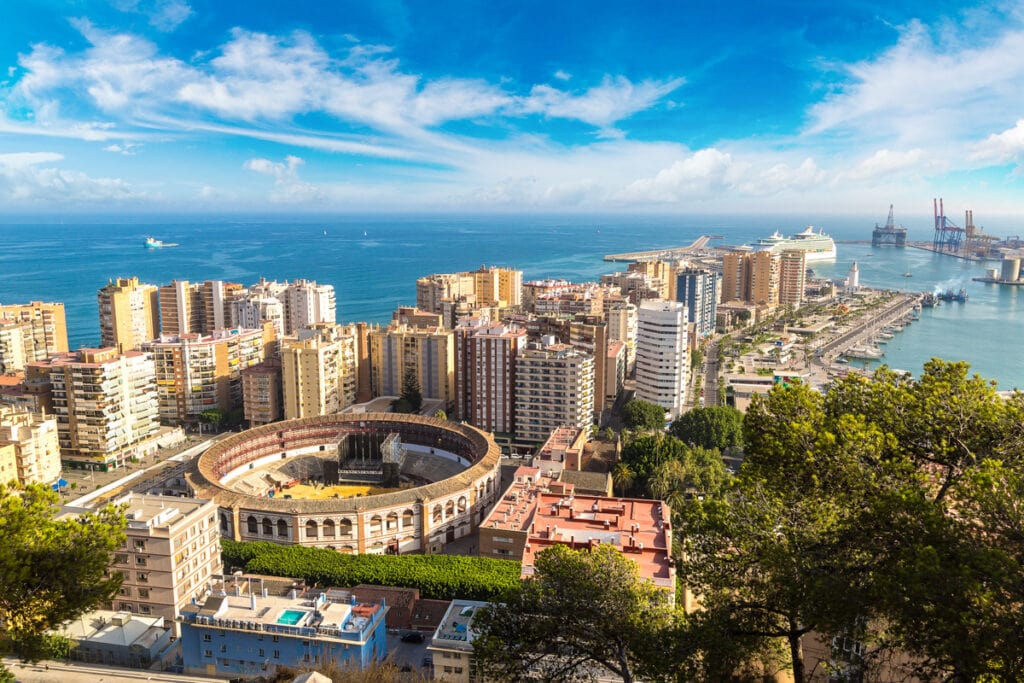
Climb up to the Gibralfaro Castle, from where the views are even more spectacular. Set high up on a hill, the 10th century castle was under siege by the Catholic Monarchs for over three months before hunger forced the locals to surrender.
Visit the Malaga Cathedral, known as La Manquita, the one-armed lady, because only one of its two towers was completed. The Renaissance cathedral houses numerous art pieces.
Also in the historic center, stop by the Museo di Picasso, housed in the beautiful Buenavista Palace. Picasso was born in Malaga, and the museum houses over eight decades of the artist’s works.
The other notable art museum in Malaga is the Carmen Thyssen Museum. Its focus is 19th century Andalusian art. The museum is housed in a historic 16th century building.
Garden lovers will want to allow some time to stroll through the lovely Jardín Botánico Histórico La Concepción. You’ll find themed gardens here, around the original historic garden. The gardens offer beautiful views over the city.
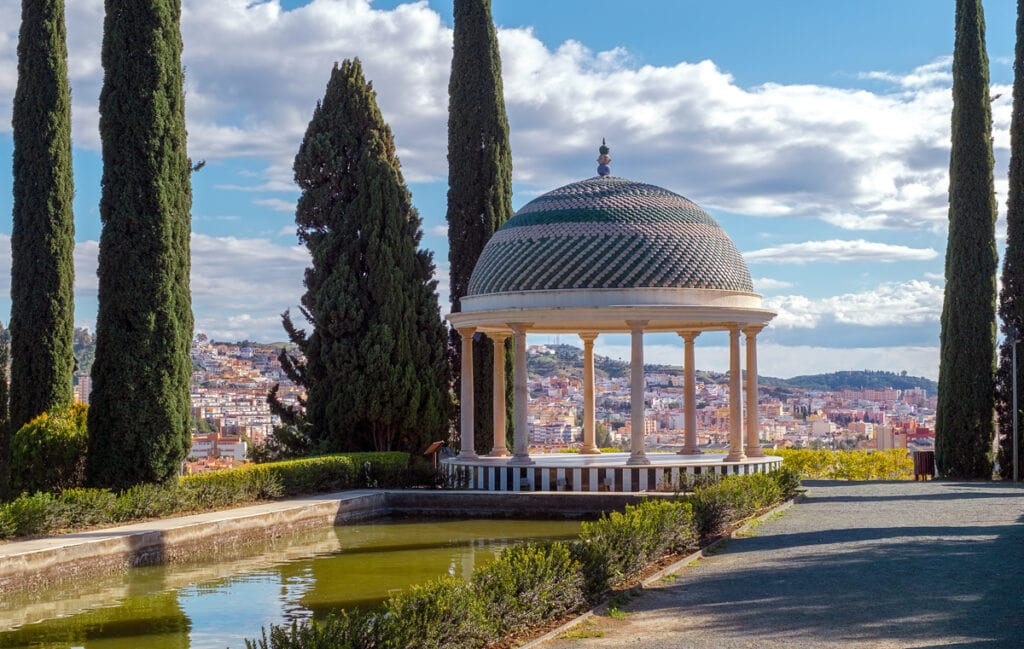
The city is located on Spain’s famous Costa del Sol, and enjoying the beaches is one of the best things to do in Malaga.
La Malagueta Beach is right by the port, and hugely popular because of the ease of access. The beach is well-maintained, with amenities, and a great place to spend the afternoon if you want to enjoy the sun and the sand.
You can visit Malaga any time of the year, although the warmer months are ideal if you wish to spend at least a part of your day at the beach.
Getting to Malaga from Madrid
The high-speed train is the best way, and indeed the only feasible way, of doing a day trip from Madrid to Malaga. The journey takes about 2.5 hours each way, so leave early if you want to get a few hours at the beaches in Malaga!
There are multiple departures in both directions everyday.
From the train station in Malaga, take the local bus, or a taxi, into the historic center. If you choose to walk, it’s about 20 minutes to the Malaga Cathedral in the historic core.
14. Zaragoza
Zaragoza is a must-visit for anyone interested in Spanish culture and history.
With its Roman roots and Arab influences, Zaragoza is a truly unique city, and you will find many things to do in Zaragoza.
Visit the Basílica de Nuestra Señora del Pilar. This massive baroque basilica is one of Zaragoza’s most iconic landmarks.
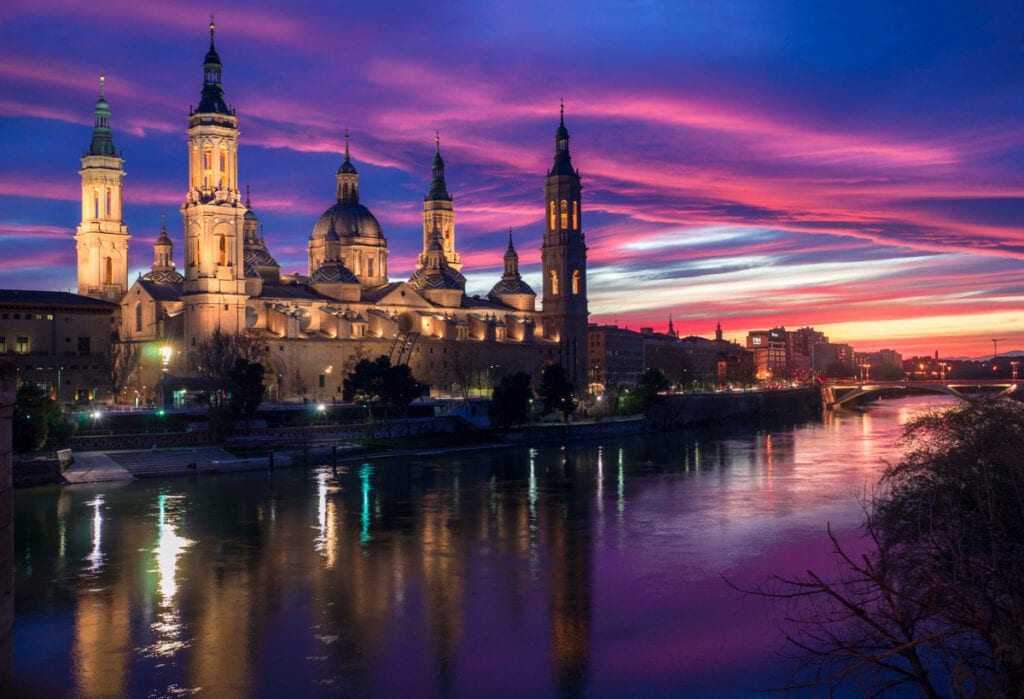
Dating back to the early 18th century, the basilica is decorated with an impressive array of sculptures, paintings, and stained glass windows.
Stroll through the Plaza del Pilar. The central square is a great place to people watch and soak up the atmosphere of Zaragoza.
The square is also home to a number of important buildings, including the Palacio de la Aljafería (a UNESCO World Heritage Site) and the Iglesia de San Pablo.
Explore La Almozara. This medieval Moorish fortress was once used as a royal palace by the Kings of Aragon.
Today, it houses a museum with an interesting collection of artifacts from Zaragoza’s past.
Don’t forget to sample the local cuisine! Zaragoza is known for its excellent food. Among the most popular dishes are tortilla de patatas (potato omelette), jamon iberico (cured ham), and gazpacho (a cold soup made with tomatoes and peppers).
Zaragoza is a great city to visit at any time of year, but the spring and autumn months are especially pleasant.
The weather is warm but not too hot, and there are plenty of activities and events taking place in the city.
If you’re looking for a good deal on hotels or flights, try visiting Zaragoza in the winter or summer months, when the prices are usually a bit lower.
If you’re looking for an adventure, then Zaragoza is the place for you. This historic city has something for everyone, from fascinating museums to delicious food. So what are you waiting for?
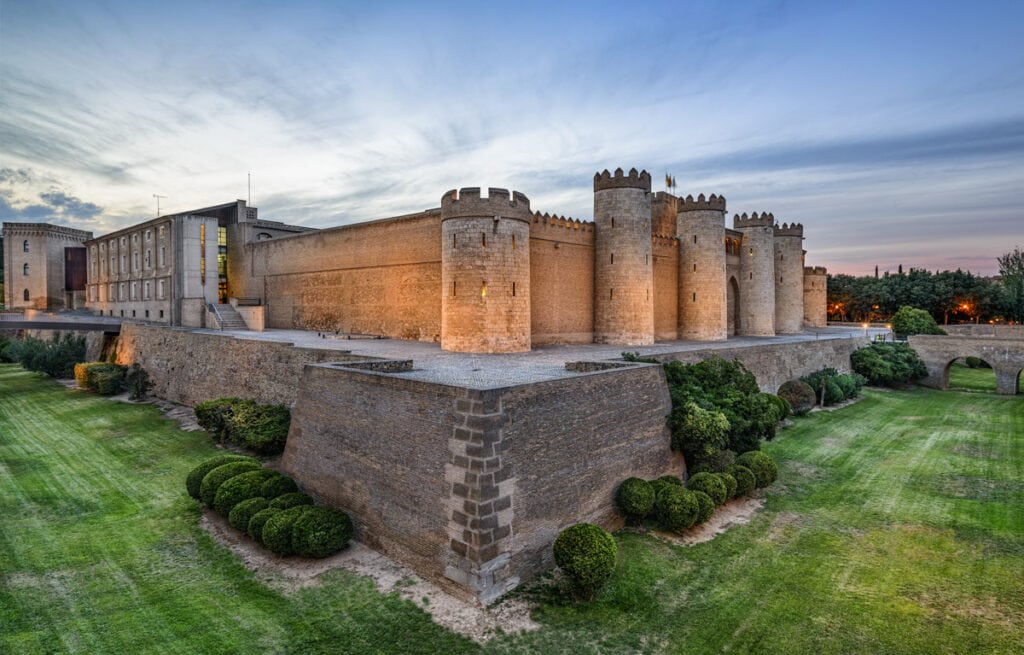
Getting to Zaragoza from Madrid
To get to Zaragoza by public transport, take the train from Madrid. The journey takes about one hour and 20 minutes, and there are frequent departures.
Zaragoza’s main railway station is located in the city center, and from there it’s easy to get around on foot or by bus.
The direct train is the best option for a day trip from Madrid, as driving takes about 3 hours each way.
Suggested by Alexander from Travel Your Memories
15. Alicante
Alicante is a city on the Costa Blanca, part of Spain’s southeast Mediterranean coast. Blessed with some of the sunniest weather in all of Europe, the city makes for a great spot to visit at any time of the year.
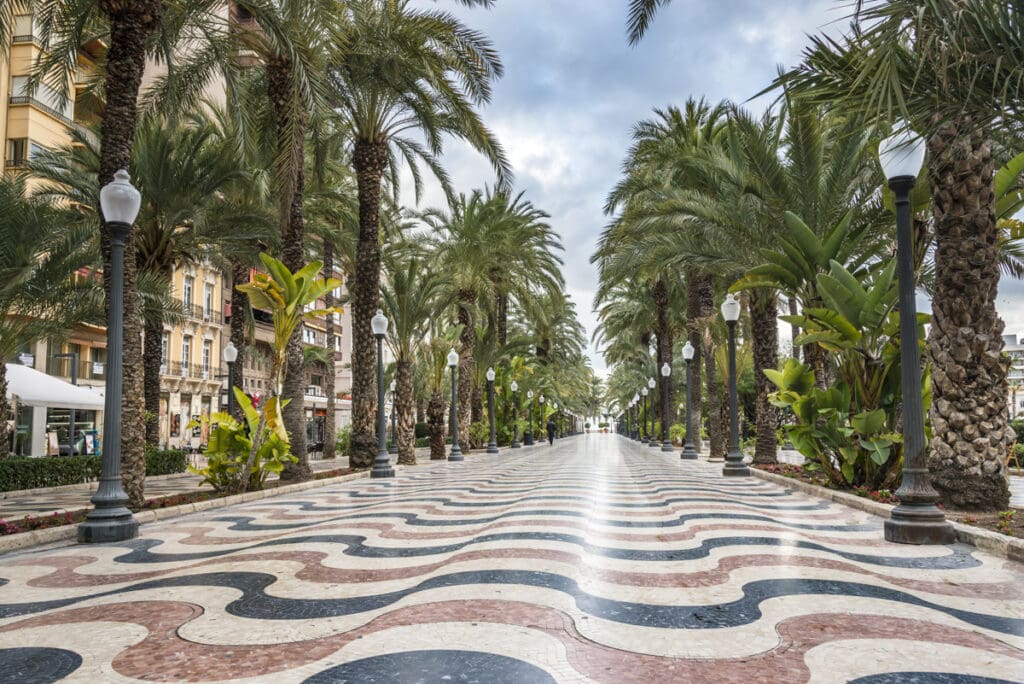
A historic port city, Alicante still retains many of its narrow old lanes and charming colorful houses, along with a vibrant restaurant and nightlife scene.
A major draw of the city are its pristine sandy beaches, some of the best city beaches that you will find anywhere.
A pleasant seafront pedestrian promenade lined with cafes, as well as several children’s playgrounds on the sand complete the offering.
For those looking for a slice of history, the city’s castle, perched high above the city, is well worth a visit.
An elevator from the seafront speeds up the long climb to the medieval Castillo de Santa Bárbara, perfect for those not wanting to take on the uphill walk.
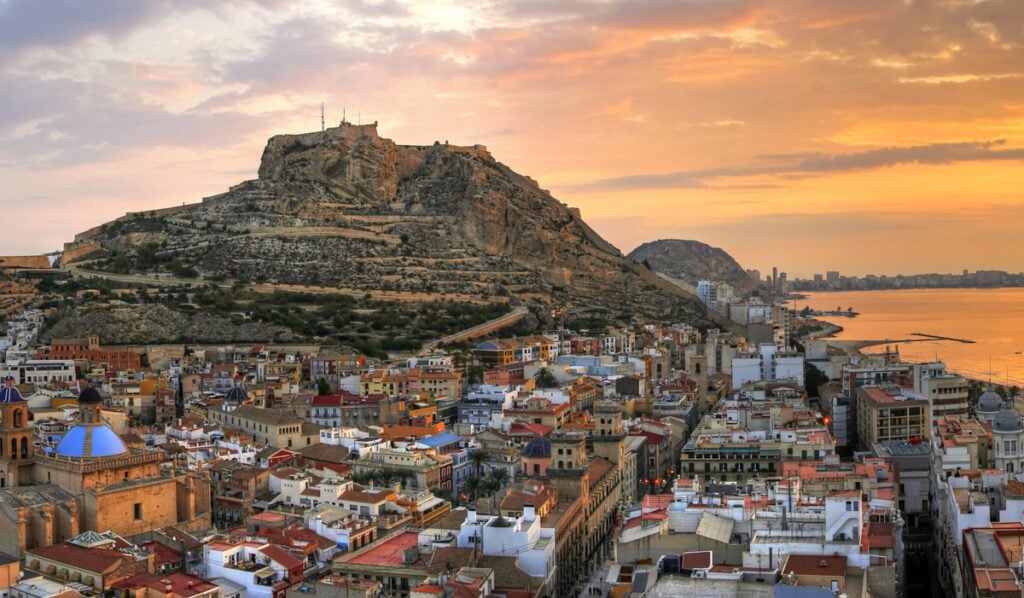
Besides the sandy beaches of summer, Alicante is also a great city to visit at Christmas time, with colorful Christmas lights decorating several of the city’s districts, as well as the world’s largest Christmas nativity scene.
Getting to Alicante from Madrid
Alicante is connected to Madrid by direct high-speed trains.
This means that it can be reached in about 2½ hours from the capital, making this trip to the beach a realistic day trip or short break option from Madrid.
Suggested by Rachel from Children of Wanderlust
16. Valencia
Valencia is a fantastic destination with historical old buildings, modern museums, green oases, and miles of sandy beaches.
The beautiful, historic old town of Valencia hales back to Roman times. Here you can find the impressive town hall, the cathedral and several great museums.
Also not to be missed are Plaza de Toros (a huge bullring still in use), and the Estació del Nord, the main train station, which is an architectural masterpiece.
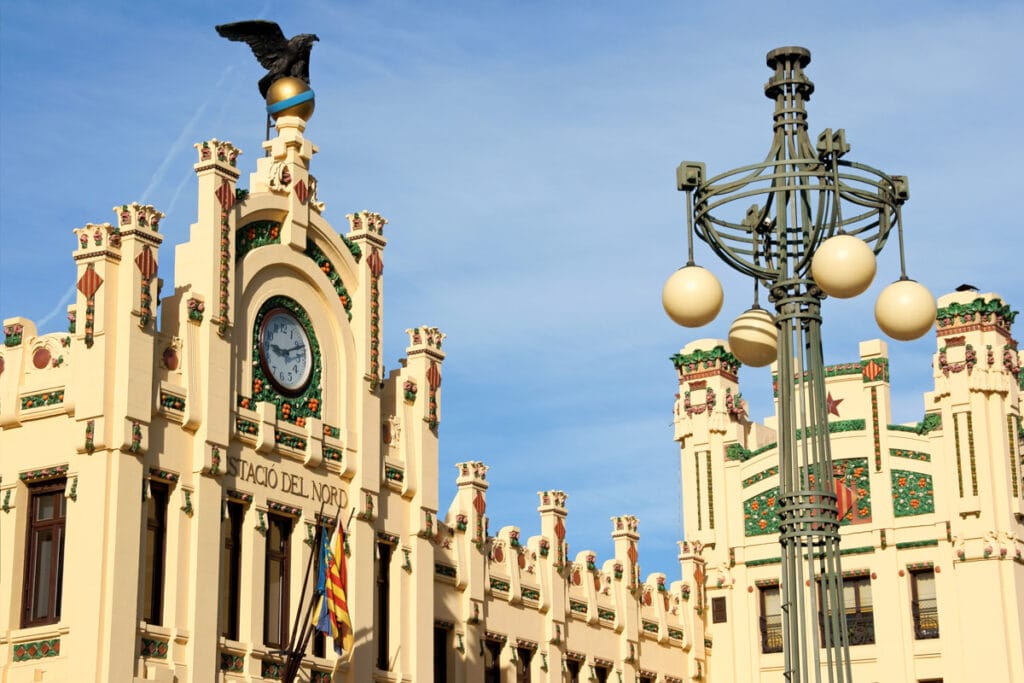
At the south-east end of Turia Park you can find the City of Arts and Sciences. This is a modern icon of Valencia and is made up of several futuristic buildings, including an aquarium and an interactive science museum.
Last but not least are the fabulous sandy beaches of Valencia.
Playa de la Malvarossa is the most famous beach, but in all honesty, all of Valencia’s urban beaches are perfect for sunbathing and relaxing.
The sea is very shallow here, which makes it perfect for families with children. Also, some of the best paella restaurants in Valencia are here!
The best time to visit Valencia is in March during Las Fallas festival.
While many people visit during the summer months, spending winter in Valencia is actually even better.
Few other places in Europe have such a mild climate that let you enjoy the outdoors to the max even in January.
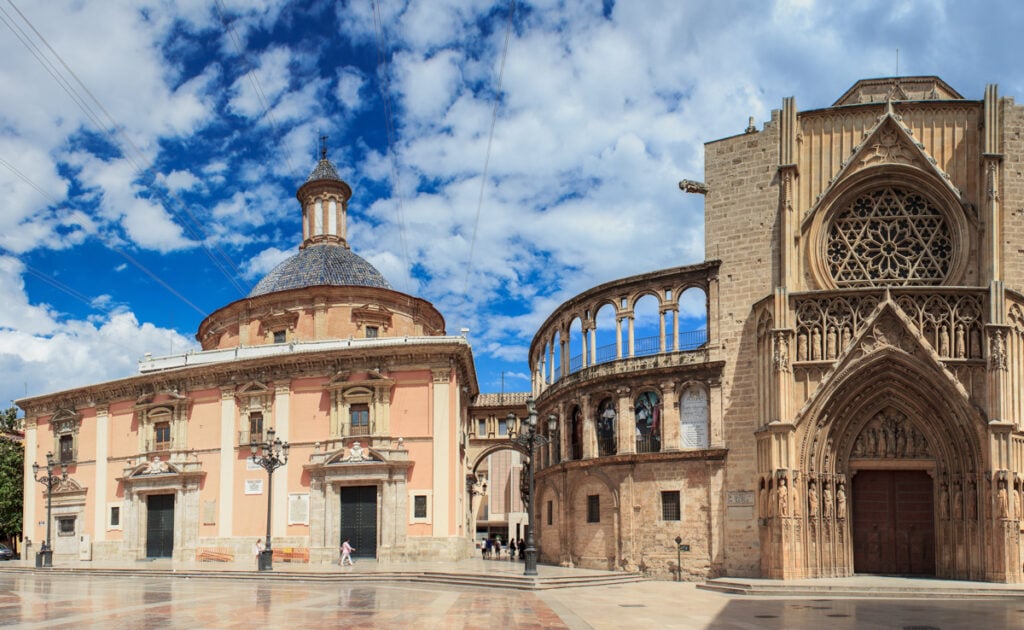
Getting to Valencia from Madrid
You can get to Valencia from Madrid by high-speed train in 1 hour and 40 minutes.
Arrive at the Joaquin Sorolla station in Valencia, from where you can walk to the old town (about 15 minutes).
The high-speed train is the only feasible transport option for a day trip from Madrid.
Suggested by Valencia Revealed
So that’s our round-up of the best day trips from Madrid! Which ones will you choose for your next trip to the capital of Spain?
*****
More Travel Inspiration for Spain
Planning a trip to Spain? Check out our in-depth itinerary for Andalusia in southern Spain.
Seville is a must-visit, but if you have the time, you can also add in some exciting day trips from Seville as well: a Seville to Cordoba day trip is very popular, but Cadiz, Jerez, Arcos de la Frontera, and Carmona are some of the other places you can visit from the Andalusian capital.
You can also do day trips from Malaga to many charming towns along the Costa del Sol, or do the hugely popular Caminito del Rey walk.
You will want to visit Granada, home to the famous Alhambra Palace. In 3 days in Granada, you can visit not only the Alhambra but also tour other sights such as the historic Albayzin and Sacromonte neighborhoods and the Granada Cathedral.
We also have an article on pros and cons if you are short on time for Andalusia and wondering whether to visit Granada or Seville. Fair warning, it’s a tough choice!
Looking for smaller places to add to your itinerary for Andalusia? Check out the charming white village of Casares, one of the most picturesque white villages in Spain, or plan to spend one day in Ronda, admiring the Puente Nuevo and the stunning views of the countryside.
If you are planning to go broader in Spain, you must consider one of these amazing Spain road trips! Or check out our in-depth 10 day itinerary for Spain.
Barcelona is of course a must on any itinerary for Spain, and we have an epic 3-day itinerary for Barcelona. Consider adding a few day trips from Barcelona to explore other nearby destinations such as Girona, Montserrat, or the Costa Brava, including some pretty white villages.
Did you find this article informative? Pin it for later reference!
